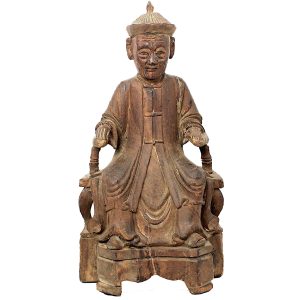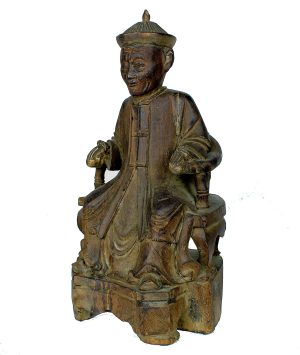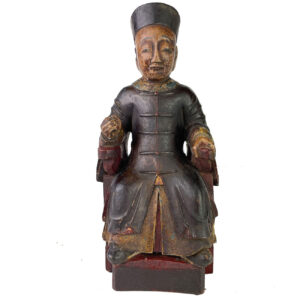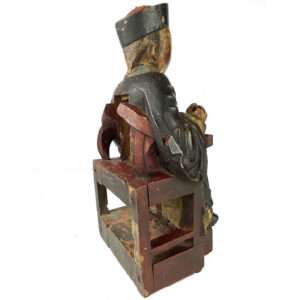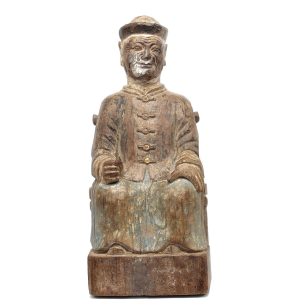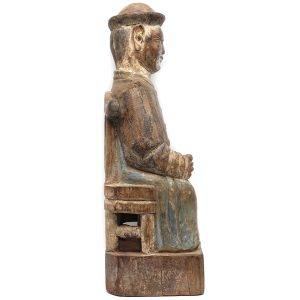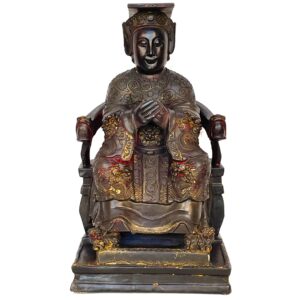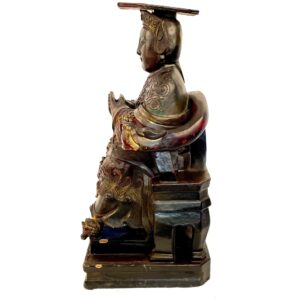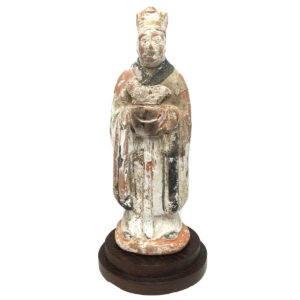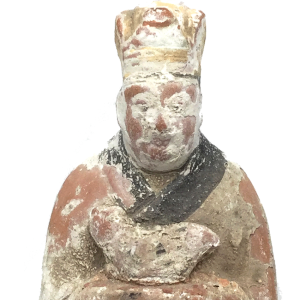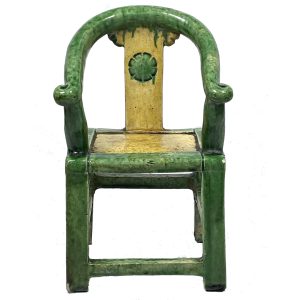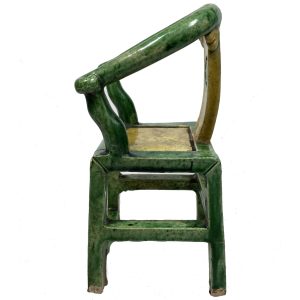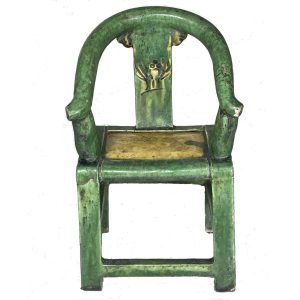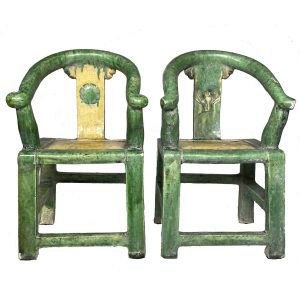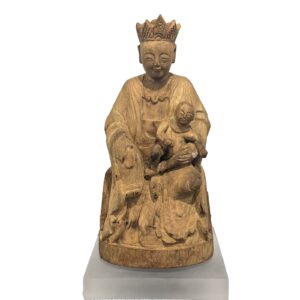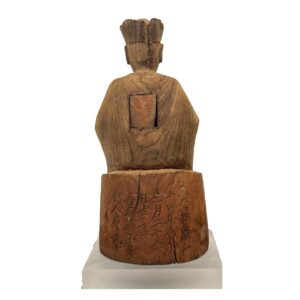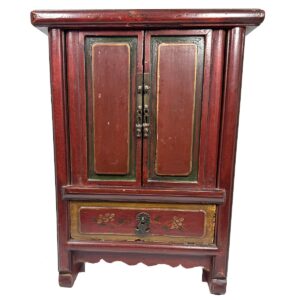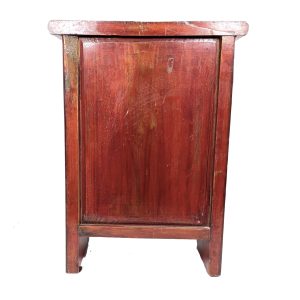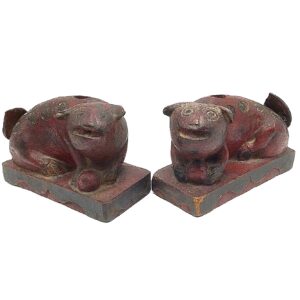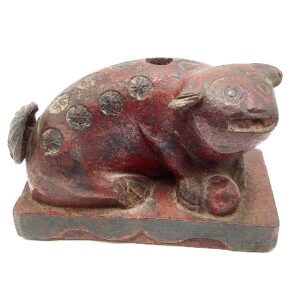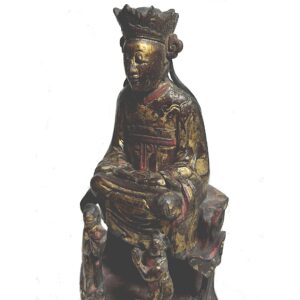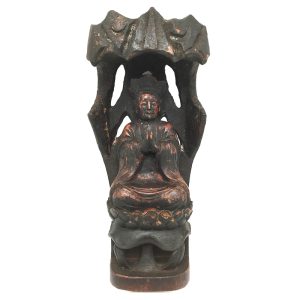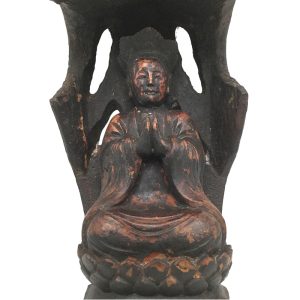Showing 109–120 of 313 results
-


$850.00
H: 12.75” W: 6.625” D: 5.75” | FREE SHIPPING within Continental u.s.
This masterfully carved ancestor as a mandarin official sits on horseshoe chair set on a footed high decorated plinth dressed in a well-appointed formal 3-button Mandarin long coat and pointed rattan hat. His face is uniquely and unusually individualized with heavy lidded eyes, in a benevolent expression and his advanced aged indicated by the wrinkles clearly depicting a loved individual. This exquisitely carved image in excellent condition with a fine patina was true homage to a revered family member and is one of our finest ancestor figures.
-
Sale!


$455.00 Original price was: $455.00.$295.00Current price is: $295.00.
H:8.5 ” W: 4 ” D: 3.3 ” | FREE SHIPPING WITHIN CONTINENTAL U.S.!
Portrayed as an official, this ancestor figure sits on a horseshoe chair showing his status wearing compulsory officials attire: a 5-button Mandarin long coat with a round collar and official headwear – a woven hat whose shape and color reflected his rank. His personalized personalized oval-shaped is tranquil with a hint of a smile on his pursed lips, and a triangular pigtail down his back.
-


$595.00
During the Qing Dynasty, reverence for Mandarin officials and their associated high status with it was so significant that families sought to perpetuate this image through the generations in carved and painted renderings of their ancestors. Ancestor-figures were the highest form of filial piety, and ancestor-worship was a cornerstone of Confucianism. Stuart (p. 82) states…
-
Sale!


$1,050.00 Original price was: $1,050.00.$750.00Current price is: $750.00.
H: 15.375” W: 8.625” D: 7.5” | FOR a SHIPPING quote CONTACT US AT 213-568-3030 or email [email protected]
This Mazu, the protector of sea farers, is portrayed as the imperially sanctioned “Empress of Heaven” seated on an elaborate horseshoe shaped dragon throne, hands clasped symbolically holding a hu tablet, adorned with elegant dragon robes, an official’s girdle, a flat-topped Empress headdress and small feet resting on a pair of gilt fu lions. Meant to be seen from all sides this beautiful carving is decorated on front and back.
-


$395.00
In China a set of earthenware Zodiac attendant figures was made as a 12 piece grouping, with each figure holding a small calendar animal with each year represented by a different animal – rat, ox, tiger, rabbit, dragon, snake, horse, goat, monkey, rooster, dog, and pig or boar – in a repeating 12-year cycle. Although…
-


$685.00
H: 7.375″ W: 4.375″ D: 3.75″ | FREE SHIPPING WITHIN CONTINENTAL U.S.!
Often ancestral figures were portrayed sitting in horseshoe chairs to reflect their high status. As many earthenware mingqi, this well-modeled chair has a liberally applied green glaze resulting in expected drips around the stretchers. The seat is decorated with a yellow glaze imitating caning and the decorative carved design on the splat also has a green glaze and a carved decorative “clocklike” circular design. The bottom of the seat and legs are not usually glazed. In very good condition with expected minor chips and minor glaze deterioration consistent with its age and long burial, it pairs perfectly with item 3330 and together would add to a fine collection of Chinese ceramics or brighten up a small space.
-


$685.00
H: 7.375″ W: 4.375″ D: 3.75″ | FREE SHIPPING WITHIN CONTINENTAL U.S.!
This charming miniature Ming dynasty ceramic horseshoe pottery chair is an accurate model of an impressive beautifully grained hardwood Ming chair with a continuous horseshoe shaped top rail and a caned seat. The curved splat of a wood chair might have either carved or pierced motifs or medallions and straight or curved stretchers joining the legs in pairs at the same height on each side. Often ancestral carved figures were portrayed sitting in horseshoe chairs and reflect the high status of the figure they were portraying. This ceramic mingqi (burial item) has a thick green glaze throughout which was liberally applied normal usual drips around the stretchers. The seat is decorated with a yellow glaze in imitation of caning as is the decorative carved design on the splat, but the bottoms of the seat and legs are unglazed. The rail ends splay to the right and left for hand comfort and decorative effect are traditionally found in Ming Dynasty hardwood chairs. In very good condition with minor chips and paint losses, it was buried underground in a tomb for centuries. This would be a fine addition to a collection of antique ceramics or simply a beautiful decorative piece to brighten a small space.
-


$1,350.00
H: 11” W: 5.75” D: 5.125” | FREE SHIPPING WITHIN CONTINENTAL U.S.!
This very rare and fine 16th century home shrine image displays the benign and compassionate countenance of Songzi Guanyin the “Bestower of Children.” With round face and joyful half-closed and eyes, she looks lovingly at the child whose arm is draped over hers.and leans slightly forward, wearing a 5- lobed crown centered with a camellia flower a Chinese symbol of young sons and daughters. The inscription on the back dates the piece to 1521-1567
-
Sale!


$435.00 Original price was: $435.00.$375.00Current price is: $375.00.
Ht: 15.25″ W: 11″ D: 4.875″ | CALL 213-568-3030 OR EMAIL [email protected] FOR SHIPPING COST
Small red and gold decorated and carved cabinets like this were wedding gifts, often by parents, as a wish for the young couple to be fertile and have many sons. Auspicious symbols here include a peony a metaphor for female beauty and fertility and a willow, like the peony, representing spring – the season of youth, new beginnings, optimism and fertility.
-


$250.00
This stylized pair of folk art tigers covered with lacquer and highlighted with black pigment was likely part of a larger item, as there are indentations on top to insert vertical extensions. The tiger is one of many ancient mythical animals, and as the mount of the Taoist god Heavenly Master Zhang Tianshi tiger images,…
-


$1,450.00
This delicate antique carving is Nanhai Guanyin of the South Sea, a popular manifestation of her created during the Ming and Qing Dynasties. The Ming saw a revival of Buddhism and Buddhist art, as Guanyin cults appeared throughout China, scores of new Guanyin temples were built and her status was fueled by popular literature such…
-


$450.00
This small antique carving is Nanhai Guanyin (Guanyin of the Southern Seas) who became a syncretic cult figure during the late Ming and Qing dynasties in rural provincial regions, especially Southern China. She is worshiped in Mahayana Pure Land Buddhism, Taoism and Popular Religion. The local artisan took liberties in the iconography, portrayal and attributes…
End of content
End of content

